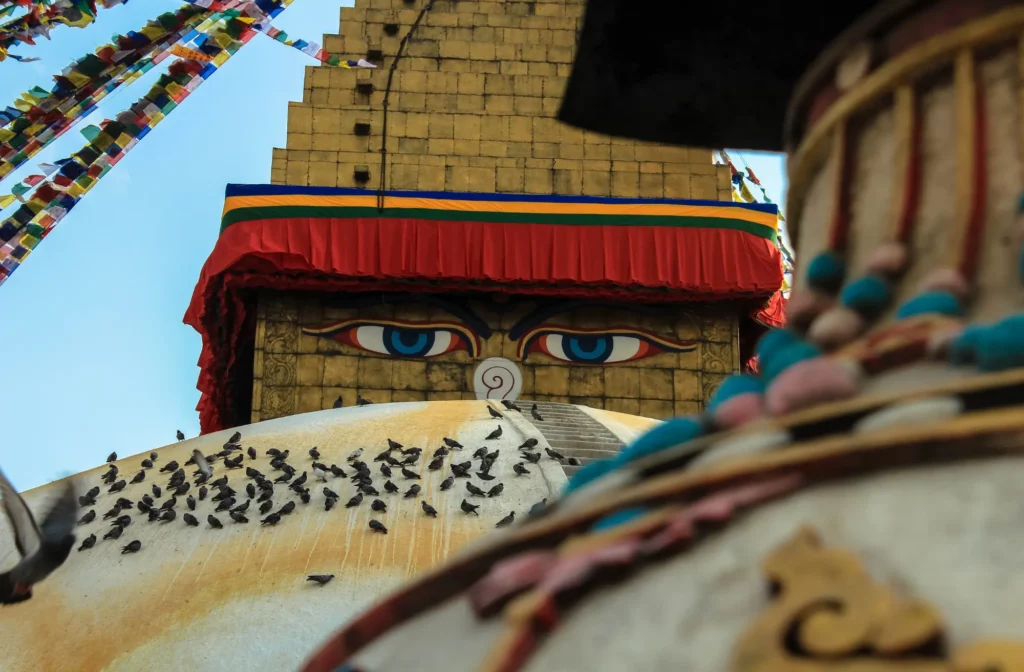
When you think of Nepal, the majestic peaks of the Himalayas often come to mind. Yet, amidst the allure of towering mountains and trekking adventures lies a spiritual sanctuary that captivates the soul—Boudhanath Stupa. This awe-inspiring monument, a beacon of peace and spirituality, is more than just an architectural marvel. It’s a place where history, culture, and spirituality converge, offering a serene escape from the hustle and bustle of urban life.
The Meaning Behind Boudhanath Stupa
Boudhanath Stupa, also known as Boudhanath or Boudha, is one of the largest stupas in the world. This is a significant site of pilgrimage and meditation for Tibetan Buddhists.
The stupa’s design is rich in symbolism. The massive mandala of the stupa represents the Buddhist cosmos. The eyes painted on all four sides of the stupa’s tower, often referred to as the “Eyes of Buddha,” symbolize the all-seeing nature of Buddha. These eyes are a reminder of the Buddha’s compassion and omnipresence, watching over the world and guiding believers on the path to enlightenment.
A Glimpse into History
The origins of Boudhanath Stupa date back to the 5th century AD. Though, some legends suggest it was built during the reign of King Manadeva in the 4th century. The stupa has undergone several renovations over the centuries, reflecting its enduring significance in Buddhist culture. It is believed that the stupa entombs a relic of the Buddha, making it a highly revered site.
Boudhanath gained prominence after the 1959 Tibetan uprising, as many Tibetan refugees settled in the area, transforming it into a thriving center of Tibetan culture in Nepal. The influx of refugees led to the establishment of over 50 Tibetan gompas (monasteries) around Boudhanath. Which further enrich its spiritual ambiance.
UNESCO World Heritage Status
In 1979, Boudhanath Stupa was designated a UNESCO World Heritage Site, recognizing its historical, cultural, and religious significance. This status has helped preserve the stupa and its surrounding areas, ensuring that the rich traditions and architectural splendor remain intact for future generations.
The UNESCO designation also underscores the stupa’s role as a symbol of peace and unity, attracting visitors from around the world.
Why Visit Boudhanath Stupa?
Even if your primary goal in Nepal is to explore its rugged mountains, Boudhanath Stupa offers a unique experience that shouldn’t be missed. Here’s why:
1. Spiritual Serenity
The atmosphere around Boudhanath is profoundly peaceful. As you walk clockwise around the stupa, spin the prayer wheels and listen to the hum of monks chanting, you’ll feel a sense of tranquility that is hard to find elsewhere in the city. It’s a perfect spot for meditation and reflection. Offering a break from the physical demands of trekking.
2. Cultural Richness
Boudhanath is a vibrant hub of Tibetan culture. The surrounding streets are lined with shops selling traditional Tibetan crafts, thangka paintings, and spiritual items. Visiting the local monasteries, you can witness the daily rituals of monks and engage with the local Tibetan community, gaining insight into their way of life.
3. Architectural Marvel
The stupa itself is an architectural wonder. Its massive white dome, topped with a golden spire adorned with colorful prayer flags, stands out against the Kathmandu skyline. The intricate details and the sheer scale of the structure are awe-inspiring, making it a photographer’s delight.
4. Festivals and Celebrations
Throughout the year, Boudhanath hosts various festivals that are a feast for the senses. The most notable is the Tibetan New Year, Losar, celebrated with fervor and vibrant festivities. During these times, the stupa and its surroundings come alive with dances, music, and traditional ceremonies. It offers a deeper understanding of Tibetan Buddhism.
More than ‘Just a Monument’
Boudhanath Stupa is a living, breathing testament to Nepal’s rich spiritual heritage. Whether you’re a spiritual seeker, a culture enthusiast, or just looking for a serene escape, Boudhanath offers a unique and unforgettable experience.
So, as you plan your adventures in the mountains, make sure to carve out time to visit this beautiful place in Kathmandu.







